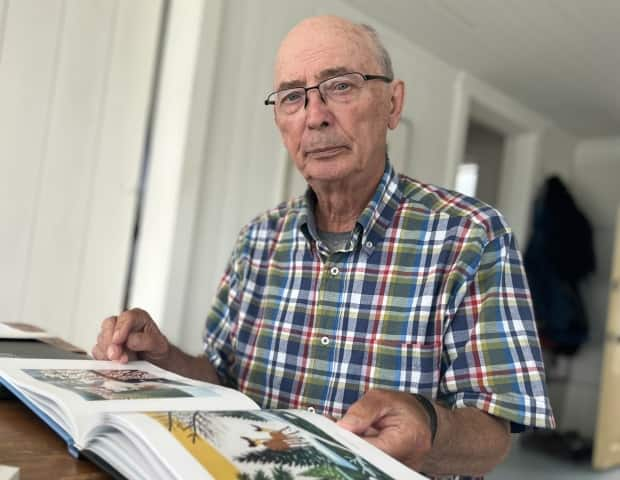Soaring value of Maud Lewis works invites fraud, art experts say

Some art experts are cautioning that the soaring value of Maud Lewis paintings will make the Nova Scotia folk artist's work more attractive for fraudsters to replicate.
Making Maud frauds isn't new, with allegations dating back decades. One of the people accused of making forgeries of her work was her husband, Everett Lewis, after Maud's death in 1970.
The Nova Scotia government even purchased what it thought were three Lewis works in 1982, which were found to be frauds four decades later. Two of those paintings were even hung in the premier's office.
While Lewis sold her paintings for a few dollars each, her paintings now routinely sell for tens of thousands of dollars. Experts say these prices, coupled with a lack of an appetite for prosecuting art fraud in Canada, create a market ripe for fraud.
"That proliferation is always going to accelerate as prices go higher, and they certainly have been going higher," said art fraud lawyer Jonathan Sommer of Toronto's Sommer Law. He said art fraud accounts for almost half of his practice's work.
He's spent thousands of hours working on cases, most notably involving Norval Morrisseau, the renowned, late Indigenous artist.
Sommer represented Barenaked Ladies keyboardist Kevin Hearn, who was awarded $60,000 in damages by the Ontario Court of Appeal, after a Toronto gallery sold him a fake.

Earlier this year, the Thunder Bay Police Service and Ontario Provincial Police announced eight people were facing 40 charges in relation to alleged massive rings that created fraudulent Morrisseau artwork. The investigation seized more than 1,000 pieces of fraudulent artwork.
Ian Muncaster, the owner of Zwicker's Gallery in downtown Halifax, was hired by the Nova Scotia government last fall to determine whether its three Mauds were fakes.
He said people bring in around a dozen Lewis paintings in the run of a month. He said two or three will be frauds.
"Her style is easy to copy and the fact that she did the same image over and over again, repeatedly, it made it easier still for forgers," said Muncaster.
He said Lewis once said she did a painting a day for around three decades, which would work out to more than 10,000 paintings.

Alan Deacon is called upon several times a month to authenticate Lewis's work. He said they are authentic more than 90 per cent of the time.
Around 10 years ago, he spotted a supposed Lewis for sale on eBay from a seller in Budapest, Hungary. The person was also selling works from other notable artists, including Frida Kahlo, Stephen Lowry and Beatrix Potter.
"And I thought, 'There's no way that this obscure little site in Hungary would have legitimate paintings by all these people.' It just seemed crazy," said Deacon, who lives in Nova Scotia's Annapolis Valley.
It's unclear whether the painting was produced in Hungary, Nova Scotia or somewhere else.

"But I think when people do speak about sophisticated fakes and where they come from, I think Eastern Europe is one of the places that people do talk about, so it's highly likely that it could have come from there," said Deacon.
Sommer's experience has been that there isn't much interest in prosecuting art fraud in Canada. He said there are several reasons why, including that it's not viewed as a serious crime.
"I like to call that the myth of the charming rogue, which is the idea that art fraudsters are these criminals who are more charming and more amusing than they are real criminals, and that the crimes that they commit are crimes committed generally against people with more money than they know what to do with and not very many brains," he said.
Sommer said with art fraud, the victim still has a painting on their wall afterwards unlike a fraudster who steals money from somebody.


He said Canada doesn't have the expertise in its police and judicial systems to deal with art fraud the way that European countries do.
Sommer said he'd like to see the RCMP have a dedicated art fraud unit that could assist police forces across the country.
In a statement, the RCMP confirmed they don't have a national art fraud unit and are unaware of any RCMP forces having a local one.
"Any art theft would be handled by the police of jurisdiction for where the incident occurred," it said.
Cory Dingle, the CEO of Morrisseau's estate, said because art fraud increases the supposed supply of legitimate works, it drags down prices for prominent artists, as well as other artists.
"What is the second, third, fourth, 50th, 500th artist going to get? Nothing," he said.
Dingle said when people buy art, they're buying what the artist represents. For Morrisseau, he said it's the perseverance of an individual who was a residential school survivor.

Dingle also sees perseverance in Lewis.
"Why I love Maud Lewis is because of her life, her challenges, her physical challenges," he said.
"I would buy a Maud Lewis because it shows an endearing strength of a human being — a little, tiny creature to keep going and keep producing art."
Dingle said Canada needs to take art fraud more seriously.
"We need the authorities, we need the government, we need the art market, we need the academics to all come together and look at other cultures that have dealt with this … and show the world that we can do better," he said.

Asked what advice he has for people buying art, Sommer said they should try to buy directly from living artists or the galleries they work with to ensure authenticity.
But when an artist is dead, it becomes more complicated. Sommer said people could hire an investigator or get forensic testing done, but that may not be financially feasible for them.
He said galleries could even provide a certificate of authenticity that doesn't expire, as well as provenance, which details the ownership history of a piece of work.
"I can tell you there are plenty of very seemingly up and up art galleries all over the world that have been shown to be selling fakes of one kind or another, so just because the gallery looks great, [it] doesn't mean that they're not selling you a fake," he said.
MORE TOP STORIES


